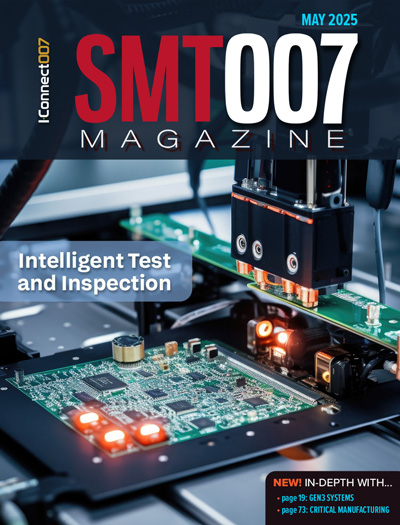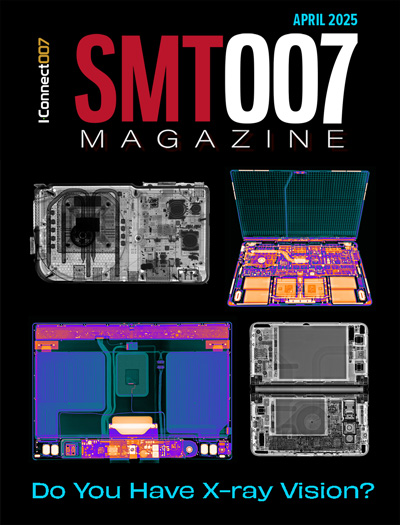-

- News
- Books
Featured Books
- smt007 Magazine
Latest Issues
Current Issue
Intelligent Test and Inspection
Are you ready to explore the cutting-edge advancements shaping the electronics manufacturing industry? The May 2025 issue of SMT007 Magazine is packed with insights, innovations, and expert perspectives that you won’t want to miss.

Do You Have X-ray Vision?
Has X-ray’s time finally come in electronics manufacturing? Join us in this issue of SMT007 Magazine, where we answer this question and others to bring more efficiency to your bottom line.

IPC APEX EXPO 2025: A Preview
It’s that time again. If you’re going to Anaheim for IPC APEX EXPO 2025, we’ll see you there. In the meantime, consider this issue of SMT007 Magazine to be your golden ticket to planning the show.
- Articles
- Columns
Search Console
- Links
- Media kit
||| MENU - smt007 Magazine
Incheon National University Study Pioneers Breakthrough in Wireless Charging Technology
February 21, 2025 | PRNewswireEstimated reading time: 2 minutes
The efficiency of wireless charging systems is limited by power loss occurring due to frequency changes in the resonant circuits that enable power transfer. These necessary modulations reduce electromagnetic interference caused by resonant frequencies on other devices. However, conventional strategies for adapting to changing frequencies are inefficient, cost-prohibitive, and impractical. Now, scientists have designed a resonant tuning rectifier that provides a low-cost, efficient solution to stabilize power delivery in wireless power systems.
Wireless power transfer (WPT) enables device charging without direct physical or wired connections. Resonant circuits are key components of WPT systems that optimize energy transfer from the transmitter to the receiver. In parallel compensated receivers, capacitors balance the inductance of the receiver coil to achieve resonance, reducing circuit impedance, thereby enhancing power transfer.
The electromagnetic fields generated by such receivers can interfere with other electronic devices. Controlling this interference requires modulating the system's operating frequency. However, this modulation creates a mismatch between the modulated and resonant frequencies, severely degrading power output and system efficiency. Current strategies to correct this mismatch rely on additional hardware or complex circuitry, leading to energy loss, complex control settings, and bulkier designs.
In an attempt to find an innovative solution to overcome these challenges, a group of scientists led by Professor Dukju Ahn at Incheon National University, Korea, proposed a resonant tuning rectifier (RTR) for parallel resonant receiver systems. The novel RTR features a minimalist design that synchronizes its operation with the natural rhythm of the system's primary current. "Our RTR does not require extra power components or complex feedback circuitry, rendering it more practical for real-world use," says Prof. Ahn. The study was made available online on May 14, 2024 and was published in Volume 71, Issue 12 of IEEE Transactions on Industrial Electronics on December 01, 2024.
The RTR automatically adjusts effective capacitance to tune the resonant frequency by syncing control signals with the system's current, compensating for differences between intrinsic resonance and modulation periods. Unlike existing methods, it uses a simple sensor coil to extract phase information without impacting performance, eliminating the need for transmitter-receiver communication.
Testing a 2.2 kW prototype for automobile charging showed that the RTR compensates for frequency modulation (80—90 kHz) in 70 ms, maintaining stable power output during misalignment and improving efficiency from 3.5% to 8.1%. Its zero-voltage system optimizes control settings to reduce power loss, offering a simple, cost-effective solution for real-time adaptation and stable power delivery.
"The automatic adjustment of resonant frequency impacts not only wireless charging but also induction heating, plasma generation, and power conversion," explains Prof. Ahn. "With minimal energy loss, high efficiency, stable throughput, a minimalist design, and low system impact, RTR can significantly enhance wireless power system performance," he concludes. As wireless charging becomes more widespread, the proposed RTR offers a promising solution to mitigate existing challenges, making this technology more accessible to everyday users.
Suggested Items
Bourns Introduces Line Filter Series with Ferrite Toroid Core that Delivers High Impedance Over a Broad Frequency Range
05/30/2025 | BournsBourns, Inc., a leading manufacturer and supplier of electronic components for power, protection, and sensing solutions, introduced a new filter series designed with a ferrite toroid core. Bourns specifically engineered its SRF1360 line filters to deliver high impedance over a broad frequency range.
Indium to Feature Precision Gold-Based Die-Attach Preforms at IMS 2025
05/29/2025 | Indium CorporationIndium Corporation® will feature its high-reliability, gold-based precision die-attach preforms for critical laser and RF applications, as well as 5G communications, at the International Microwave Symposium, June 15-19, in San Francisco, CA.
High-frequency EMC Noise in DC Circuits
05/29/2025 | Karen Burnham, EMC UnitedEMC isn’t black magic, but it’s easy to understand why it seems that way. When looking at a schematic like that in Figure 1, it looks like you’re only dealing with DC signals all across the board. There’s a 28 VDC input that goes through an EMI filter, then gets converted to 12 VDC power. Except in extremely rare circumstances involving equipment sensitive to magnetostatic fields, DC electricity will never be part of an EMC problem.
Huawei Single SitePower Solution Creates Four Synergies to Accelerate Site Intelligence
05/27/2025 | PRNewswireDuring the 9th Global ICT Energy Efficiency Summit in Dubai, Huawei showcased its next-generation digital and intelligent site power facility solution Single SitePower, which is set to drive the intelligent transformation of ICT energy infrastructure.
Honeywell Expands Defense Modernization Efforts in Japan with New Aerospace Technologies
05/26/2025 | HoneywellHoneywell announced the expansion of its support for Japan’s defense modernization efforts with the delivery of advanced aerospace systems for two key helicopter programs. These latest awards expand Honeywell’s footprint in Japan’s defense sector and reinforce the company’s commitment to mission readiness and long-term operational performance.


